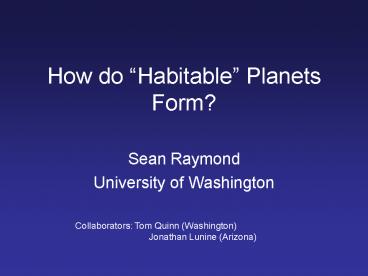How do Habitable Planets Form - PowerPoint PPT Presentation
1 / 31
Title:
How do Habitable Planets Form
Description:
To guide the Habitable Planet Search (TPF, Darwin), we need to know: ... Most of Earth's water was accreted during formation from bodies past snow line ... – PowerPoint PPT presentation
Number of Views:58
Avg rating:3.0/5.0
Title: How do Habitable Planets Form
1
How do Habitable Planets Form?
- Sean Raymond
- University of Washington
Collaborators Tom Quinn (Washington) Jonathan
Lunine (Arizona)
2
Habitable Zone temperature for liquid water
HZ is function of planets atmosphere, type
age of star
3
Habitable Planets NEED WATER!
4
The Paradox of Habitable Planet Formation
- Liquid water T gt 273 K
- To form, need icy material T lt 170 K
?icy
rocky?
snow line
5
The Paradox of Habitable Planet Formation
- Liquid water T gt 273 K
- To form, need icy material T lt 170 K
?icy
rocky?
snow line
Local building blocks of habitable planets are
dry!
6
So where did Earth get its water?
- Late Veneer Earth formed dry, accreted water
from bombardment of comets, or
? ? ? Comets ? ? ?
Asteroid Belt
7
So where did Earth get its water?
- Late Veneer Earth formed dry, accreted water
from bombardment of comets, or - ?Some of Earths building blocks came from past
snow line, in outer Asteroid Belt Earth did not
form entirely from local material
? ? ? Comets ? ? ?
Asteroid Belt
8
To guide the Habitable Planet Search (TPF,
Darwin), we need to know
- 1. Are habitable planets common?
- 2. Can we predict the nature of extrasolar
terrestrial planets from knowledge of - Giant planet mass?
- Giant planet orbital parameters (a, e, i)?
- c) Metallicity of host star?
9
Overview of Terrestrial Planet Formation
- Condensation of grains from Solar Nebula
- Planetesimal Formation
- Oligarchic Growth Formation of Protoplanets (aka
Planetary Embryos) - Late-stage Accretion
10
Simulation Parameters
- aJUP Giant planets orbital radius
- eJUP Giant planets orbital eccentricity
- MJUP Giant planets mass
- tJUP Giant planets time of formation
- Surface density ? stellar metallicity
- Position of snow line
11
Snapshots in time from 1 simulation
Eccentricity
Semimajor Axis
12
Radial Migration of Protoplanets
13
Simulation Results
- Stochastic Process
- All systems form 1-4 planets inside 2 AU, from
0.23 to 3.85 Earth masses - Water content dry to 300 oceans (Earth has
1-10 oceans)
14
Trends
- Higher eJUP ? drier terrestrial planets
- Higher MJUP ? fewer, more massive terrestrial
planets - Higher surface density ? fewer, more massive
terrestrial planets
15
Effects of eJUP
16
Habitability
- In most cases, planet forms in 0.8-1.5 AU
- In 1/4 of cases, between 0.9-1.1 AU
- Range from dry planets to water worlds with 30
times as much water as Earth
17
43 planets between 0.8-1.5 AU
18
11 planets between 0.9-1.1 AU
(1)
(2)
(3)
(4)
19
What might planets around other stars look like?
(1) aJUP 4 AU
(2) MJUP 10 MEARTH
(3) MJUP 1/3
(4) Solar System
Images from NASA
20
Conclusions
- Most of Earths water was accreted during
formation from bodies past snow line - Terrestrial planets have a large range in mass
and water content - Habitable planets common in the galaxy
21
Conclusions Contd
- Terrestrial planets are affected by giant
planets! Can predict the nature habitability
of extrasolar terrestrial planets - - Useful for TPF, Darwin
- Future develop a code to increase number of
particles by a factor of 10
22
Additional Information
- 2004 Icarus paper, Making other Earths...
- http//www.astro.washington.edu/raymond
- Papers by John Chambers
- Talk to me!
23
Additional Slides
24
What is a habitable planet?
- Habitable Zone Temperature for liquid water on
surface - 0.8 to 1.5 AU for Sun, Earth-like atmosphere
- varies with type of star, atmosphere of planet
- Habitable Planet Need water!
25
Initial Conditions
- Assume oligarchic growth to 31 resonance with
Jupiter - Surface density jumps at snow line
- Dry inside 2 AU, 5 water past 2.5 AU, 0.1 water
in between - Form super embryos if Jupiter is at 7 AU
26
Simulation Parameters
- aJUP 4, 5.2, 7 AU
- eJUP 0, 0.1, 0.2
- MJUP 10 MEARTH, 1/3, 1, 3 x real value
- tJUP 0 or 10 Myr
- Surface density at 1 AU 8-10 g/cm2
- Surface density past the snow line
27
Simulations
- Collisions preserve mass
- Integrate for 200 Myr with serial code called
Mercury (Chambers) - 6 day timestep
- currently limited to 200 bodies
- 1 simulation takes 2-6 weeks on a PC
28
Data from our Solar System
Raymond, Quinn Lunine 2003
29
Oligarchic Growth growth by the few
- Protoplanets grow faster closer to the Sun!
- Take approx. 10 Myr to form at 2.5 AU
- Mass, distribution depend on surface density
Kokubo Ida 2002
30
(No Transcript)
31
Distributions of Terrestrial Planets































